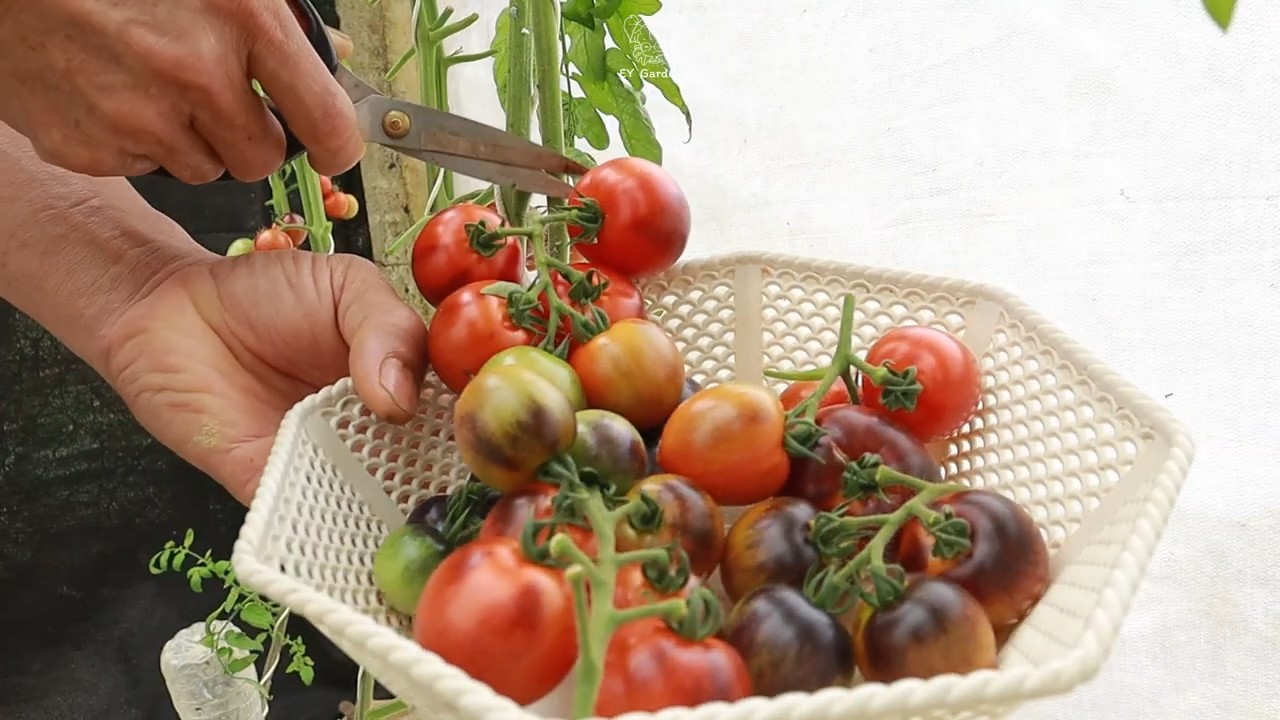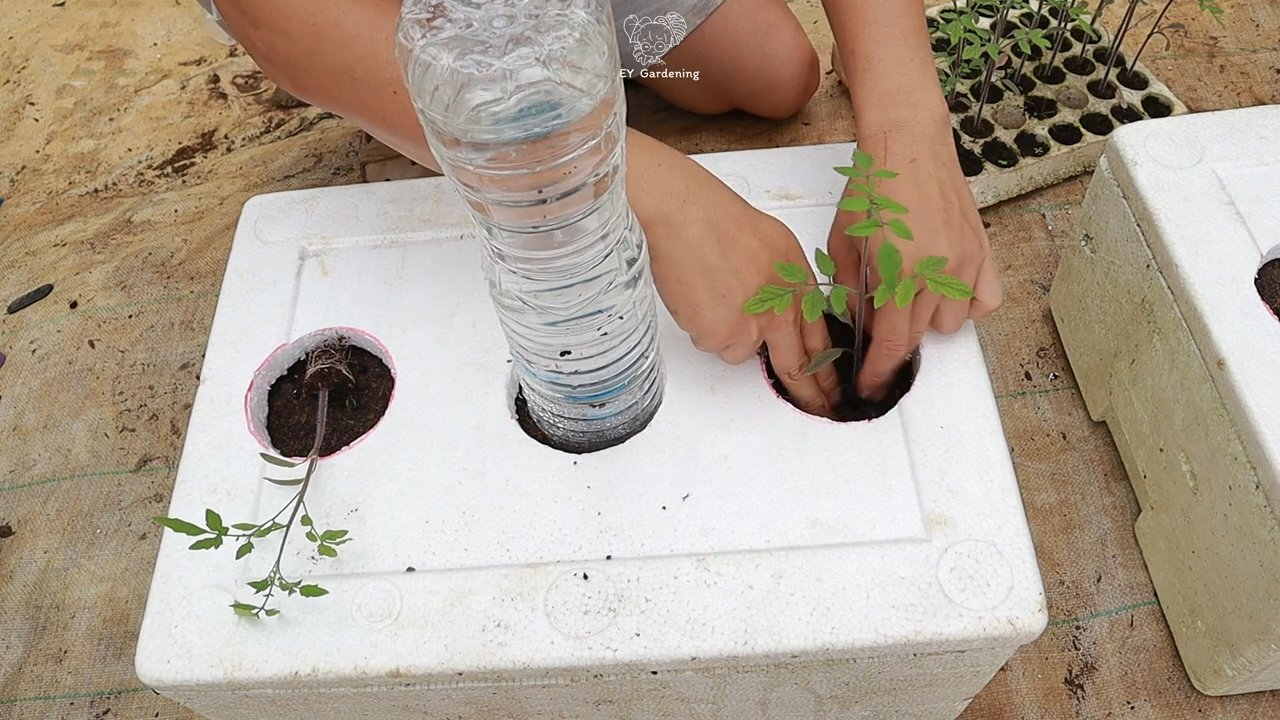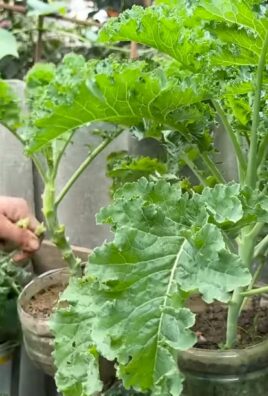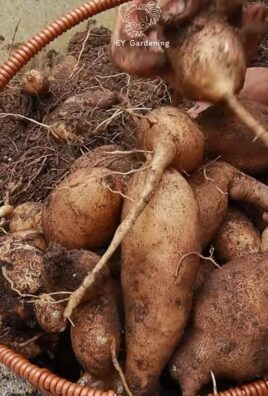Grow Black Tomatoes at Home? Absolutely! Imagine plucking juicy, almost-black tomatoes straight from your own garden – it’s easier than you think, and I’m here to show you how! For centuries, gardeners have been captivated by the allure of unusual and striking varieties, and black tomatoes, with their rich, complex flavor, are no exception. While their exact origins are debated, many believe they trace back to regions of Eastern Europe, where heirloom varieties were carefully cultivated and passed down through generations.
But why should you bother with this DIY project? Well, beyond the sheer bragging rights of growing something so unique, black tomatoes offer a depth of flavor that you simply won’t find in your average supermarket tomato. They’re packed with antioxidants and boast a sweetness that’s perfectly balanced with a slightly smoky, earthy undertone. Plus, let’s be honest, adding a touch of the unusual to your garden is just plain fun! This article will provide you with simple, step-by-step instructions and insider tips to successfully grow black tomatoes at home, even if you’re a complete beginner. Get ready to impress your friends and family with your homegrown, dark-hued delights!

Grow Black Tomatoes at Home: A Gardener’s Guide
Hey there, fellow gardening enthusiasts! Ever dreamt of adding a touch of mystery and intrigue to your garden (and your plate!)? Well, look no further than the captivating black tomato. These beauties aren’t just visually stunning; they also boast a rich, complex flavor that’s unlike any other tomato you’ve ever tasted. I’m going to walk you through everything you need to know to successfully grow black tomatoes right in your own backyard. Trust me, it’s easier than you think!
Choosing Your Black Tomato Variety
First things first, let’s talk about variety. Not all black tomatoes are created equal! Each variety has its own unique characteristics, so choosing the right one is crucial. Here are a few popular options:
* Black Krim: This is a classic for a reason. It’s known for its deep, smoky flavor and slightly salty taste. The fruits are typically medium to large in size and have a flattened, slightly irregular shape.
* Cherokee Purple: Don’t let the name fool you; this one’s definitely in the black tomato family. It has a sweet, slightly tangy flavor and a beautiful dusky rose-purple color with dark shoulders.
* Black Prince: If you’re looking for a smaller, more manageable plant, Black Prince is a great choice. It produces smaller, almost plum-shaped fruits with a rich, earthy flavor.
* Paul Robeson: Named after the famous singer and actor, this variety is known for its intense, almost wine-like flavor. The fruits are medium-sized and have a deep mahogany color.
* Japanese Black Trifele: This pear-shaped tomato is a real showstopper. It has a unique, slightly sweet flavor and a beautiful dark reddish-brown color.
I personally love growing Black Krim and Cherokee Purple because of their robust flavors and reliable yields. But feel free to experiment and find the variety that best suits your taste and growing conditions!
Starting Your Black Tomato Seeds
Okay, now that you’ve chosen your variety, let’s get those seeds started! You can either buy seedlings from a local nursery or start your own seeds indoors. I prefer starting my own seeds because it gives me more control over the process and allows me to get a head start on the growing season.
Here’s what you’ll need:
* Tomato seeds (of course!)
* Seed starting trays or small pots
* Seed starting mix (a light, well-draining mix is essential)
* A heat mat (optional, but it helps with germination)
* A grow light (also optional, but it provides consistent light for healthy seedlings)
* A spray bottle filled with water
Here’s the step-by-step process:
1. Prepare your seed starting trays or pots: Fill each cell or pot with seed starting mix, leaving about half an inch of space at the top. Gently tap the trays to settle the mix.
2. Sow the seeds: Place 2-3 seeds in the center of each cell or pot. Cover the seeds with a thin layer of seed starting mix (about 1/4 inch).
3. Water gently: Use a spray bottle to moisten the soil. Avoid overwatering, as this can lead to damping off (a fungal disease that can kill seedlings).
4. Provide warmth and light: Place the trays or pots on a heat mat (if using) and under a grow light (if using). If you don’t have a heat mat or grow light, you can place them in a warm, sunny location.
5. Maintain moisture: Keep the soil consistently moist, but not soggy. Check the soil daily and water as needed.
6. Wait for germination: Tomato seeds typically germinate in 5-10 days. Once the seedlings emerge, remove them from the heat mat (if using) and adjust the grow light so that it’s about 2-3 inches above the seedlings.
7. Thin the seedlings: Once the seedlings have developed their first true leaves (the leaves that appear after the initial seed leaves), thin them to one seedling per cell or pot. Choose the strongest, healthiest seedling and snip off the others at the soil line.
Transplanting Your Black Tomato Seedlings
After about 6-8 weeks, your seedlings should be ready to transplant into the garden. Before you transplant, it’s important to harden them off. This process gradually acclimates the seedlings to outdoor conditions, preventing transplant shock.
Here’s how to harden off your seedlings:
1. Start slowly: Begin by placing the seedlings outdoors in a sheltered location for just an hour or two each day.
2. Gradually increase exposure: Over the next week or two, gradually increase the amount of time the seedlings spend outdoors, exposing them to more sunlight and wind.
3. Monitor the weather: Avoid exposing the seedlings to extreme temperatures or harsh weather conditions.
4. Water regularly: Keep the soil consistently moist during the hardening off process.
Once your seedlings are hardened off, it’s time to transplant them into the garden!
Here’s what you’ll need:
* Your hardened-off tomato seedlings
* A sunny location with well-drained soil
* Compost or other organic matter
* Tomato cages or stakes
* Watering can or hose
Here’s the step-by-step process:
1. Prepare the soil: Choose a sunny location in your garden with well-drained soil. Amend the soil with compost or other organic matter to improve its fertility and drainage.
2. Dig the holes: Dig holes that are slightly larger than the root balls of your seedlings. Space the holes about 2-3 feet apart.
3. Plant the seedlings: Gently remove the seedlings from their pots and loosen the root balls. Place each seedling in a hole and backfill with soil.
4. Water thoroughly: Water the seedlings thoroughly after planting.
5. Add support: Install tomato cages or stakes to support the plants as they grow. Black tomato plants can get quite large, so it’s important to provide them with adequate support.
6. Mulch: Apply a layer of mulch around the base of the plants to help retain moisture and suppress weeds.
Caring for Your Black Tomato Plants
Now that your black tomato plants are in the ground, it’s time to provide them with the care they need to thrive.
Here are some essential tips:
* Watering: Water your tomato plants deeply and regularly, especially during hot, dry weather. Aim to water at the base of the plants to avoid wetting the foliage, which can lead to fungal diseases.
* Fertilizing: Fertilize your tomato plants every 2-3 weeks with a balanced fertilizer. Look for a fertilizer that’s specifically formulated for tomatoes.
* Pruning: Prune your tomato plants regularly to remove suckers (the small shoots that grow between the main stem and the branches). Pruning helps to improve air circulation and prevent disease.
* Pest and disease control: Keep an eye out for pests and diseases, such as aphids, whiteflies, and tomato blight. Take action promptly to control any problems that arise. I like to use organic pest control methods whenever possible.
* Sunlight: Black tomatoes, like all tomatoes, need at least 6-8 hours of sunlight per day. Make sure they are planted in a location that receives plenty of sun.
* Soil pH: Tomatoes prefer a slightly acidic soil pH of around 6.0 to 6.8. You can test your soil pH with a soil testing kit and amend it if necessary.
Harvesting Your Black Tomatoes
The moment you’ve been waiting for! Harvesting your black tomatoes is the most rewarding part of the process.
Here’s how to know when your black tomatoes are ripe:
* Color: The color of the tomato will deepen and become more intense. Depending on the variety, it may turn a deep mahogany, dusky rose-purple, or almost black.
* Texture: The tomato will feel slightly soft to the touch, but not mushy.
* Smell: The tomato will have a sweet, tomatoey aroma.
To harvest your black tomatoes, simply twist them gently from the vine. Handle them carefully, as they can be delicate.
Troubleshooting Common Problems
Even with the best care, you may encounter some problems while growing black tomatoes. Here are a few common issues and how to address them:
* Blossom end rot: This is a condition that causes the bottom of the tomato to rot. It’s usually caused by a calcium deficiency. To prevent blossom end rot, make sure your soil is rich in calcium and water your plants consistently.
* Tomato blight: This is a fungal disease that can cause the leaves to turn yellow and brown. To prevent tomato blight, provide good air circulation around your plants and avoid wetting the foliage when watering.
* Pests: Aphids, whiteflies, and other pests can damage

Conclusion
So, there you have it! Growing black tomatoes at home is not just a gardening project; it’s an adventure in flavor, a testament to your green thumb, and a conversation starter all rolled into one. We’ve walked you through the essential steps, from selecting the right seeds to nurturing your plants to their full, dark, and delicious potential.
Why is this a must-try? Because store-bought tomatoes, even the heirloom varieties, often lack the intense, smoky sweetness that defines a truly exceptional black tomato. You control the growing environment, ensuring the best possible conditions for flavor development. Plus, there’s an undeniable satisfaction in harvesting something you’ve nurtured from seed to table. Imagine the look on your friends’ faces when you serve them a Caprese salad featuring tomatoes you grew yourself!
But the fun doesn’t stop there. Feel free to experiment! Try different varieties of black tomatoes, such as Black Krim, Cherokee Purple, or Black Prince, to discover your personal favorite. Consider companion planting with basil, marigolds, or carrots to enhance growth and deter pests. You can even try growing them in containers if you have limited space, just ensure they have adequate sunlight and drainage.
And don’t be afraid to get creative with your harvest. Black tomatoes are fantastic in salads, sauces, salsas, and even grilled. Their unique flavor profile adds depth and complexity to any dish. Think about roasting them with garlic and herbs for a simple yet elegant side dish, or using them to make a rich and flavorful tomato soup.
Ultimately, the success of your black tomato growing endeavor hinges on your dedication and willingness to learn. Pay attention to your plants, observe their needs, and adjust your approach as necessary. Gardening is a journey, not a destination, and there will be challenges along the way. But the reward of biting into a perfectly ripe, homegrown black tomato is well worth the effort.
We wholeheartedly encourage you to embark on this rewarding gardening experience. Start small, be patient, and don’t be afraid to ask for help. There’s a wealth of information available online and in your local gardening community.
Most importantly, we want to hear about your experiences! Share your successes, your challenges, and your tips for growing black tomatoes at home in the comments below. Let’s create a community of passionate gardeners who are dedicated to cultivating the most delicious and unique tomatoes imaginable. Your insights could inspire others to take the plunge and discover the joy of homegrown black tomatoes. So, grab your seeds, get your hands dirty, and let’s grow some amazing tomatoes together!
Frequently Asked Questions (FAQ)
What are the best varieties of black tomatoes to grow at home?
Choosing the right variety is crucial for success. Some popular and reliable black tomato varieties include:
* **Black Krim:** Known for its rich, slightly salty flavor and flattened shape. It’s a good choice for slicing and salads.
* **Cherokee Purple:** A classic heirloom with a complex, sweet, and smoky flavor. It’s a versatile tomato that’s great for eating fresh or using in sauces.
* **Black Prince:** A smaller, more compact variety that’s well-suited for container gardening. It has a sweet and slightly tart flavor.
* **Japanese Black Trifele:** Pear-shaped with a rich, earthy flavor. A good choice for sauces and canning.
* **Paul Robeson:** Named after the famous singer and actor, this variety is known for its deep, complex flavor and smooth texture.
Consider your local climate and growing conditions when selecting a variety. Some varieties are more heat-tolerant or disease-resistant than others.
How much sunlight do black tomato plants need?
Black tomato plants require at least 6-8 hours of direct sunlight per day to thrive. Insufficient sunlight can lead to leggy growth, reduced fruit production, and less flavorful tomatoes. Choose a location in your garden that receives full sun throughout the day. If you’re growing tomatoes in containers, make sure to place them in a sunny spot. If you live in a particularly hot climate, some afternoon shade may be beneficial to prevent sunscald.
What kind of soil is best for growing black tomatoes?
Black tomatoes prefer well-drained, fertile soil with a slightly acidic pH (around 6.0-6.8). Amend your soil with compost or other organic matter to improve drainage, fertility, and water retention. Avoid heavy clay soils, as they can become waterlogged and suffocate the roots. A good soil mix for container gardening would include a combination of potting soil, compost, and perlite or vermiculite.
How often should I water my black tomato plants?
Water your black tomato plants deeply and regularly, especially during hot, dry weather. Aim to keep the soil consistently moist but not waterlogged. Water at the base of the plant to avoid wetting the foliage, which can increase the risk of fungal diseases. A good rule of thumb is to water when the top inch of soil feels dry to the touch. Mulching around the plants can help retain moisture and suppress weeds.
How do I prevent common tomato diseases and pests?
Prevention is key when it comes to tomato diseases and pests. Here are some tips:
* **Choose disease-resistant varieties:** Look for varieties that are labeled as resistant to common tomato diseases such as Fusarium wilt, Verticillium wilt, and early blight.
* **Practice crop rotation:** Avoid planting tomatoes in the same location year after year, as this can allow diseases and pests to build up in the soil.
* **Provide good air circulation:** Space your plants adequately to allow for good air circulation, which can help prevent fungal diseases.
* **Water properly:** Avoid overhead watering and water at the base of the plant to prevent fungal diseases.
* **Use organic pest control methods:** Consider using organic pest control methods such as insecticidal soap, neem oil, or Bacillus thuringiensis (Bt) to control common tomato pests.
* **Remove diseased foliage:** Promptly remove any diseased foliage to prevent the spread of disease.
When should I harvest my black tomatoes?
Black tomatoes are ready to harvest when they are fully colored, slightly soft to the touch, and have a rich, tomatoey aroma. The color will deepen to a dark reddish-brown or almost black, depending on the variety. Gently twist the tomato from the vine, leaving the stem attached. Avoid squeezing the tomato, as this can bruise the fruit.
Can I grow black tomatoes in containers?
Yes, you can successfully grow black tomatoes in containers, especially if you choose a compact variety like Black Prince. Use a large container (at least 15-20 gallons) with good drainage. Fill the container with a high-quality potting mix and provide adequate sunlight, water, and fertilizer. You may also need to stake or cage the plants to provide support.
What are some good companion plants for black tomatoes?
Companion planting can help improve the growth and flavor of your black tomatoes. Some good companion plants include:
* **Basil:** Repels tomato hornworms and whiteflies.
* **Marigolds:** Repel nematodes and other soil pests.
* **Carrots:** Improve soil drainage and deter root-knot nematodes.
* **Onions and garlic:** Repel aphids and other pests.
* **Nasturtiums:** Attract aphids away from tomato plants.
Avoid planting tomatoes near brassicas (such as cabbage, broccoli, and cauliflower), as they can compete for nutrients.
How can I improve the flavor of my black tomatoes?
Several factors can influence the flavor of your black tomatoes. Here are some tips for improving flavor:
* **Provide adequate sunlight:** Sunlight is essential for sugar production, which contributes to the flavor of tomatoes.
* **Water properly:** Avoid overwatering, as this can dilute the flavor.
* **Fertilize appropriately:** Use a balanced fertilizer that is specifically formulated for tomatoes.
* **Allow the tomatoes to ripen fully on the vine:** Tomatoes that are picked before they are fully ripe will not develop their full flavor potential.
* **Add Epsom salts to the soil:** Epsom salts can help improve the flavor and sweetness of tomatoes.
How do I save seeds from my black tomatoes?
Saving seeds from your black tomatoes is a great way to preserve your favorite varieties and ensure a supply of seeds for future growing seasons. To save seeds, select ripe, healthy tomatoes from disease-free plants. Scoop out the seeds and pulp and place them in a jar with a little water. Allow the mixture to ferment for a few days, stirring occasionally. This process will help remove the gelatinous coating from the seeds. After fermentation, rinse the seeds thoroughly and spread them out on a paper towel to dry completely. Once the seeds are dry, store them in an airtight container in a cool, dark place.




Leave a Comment